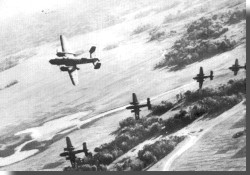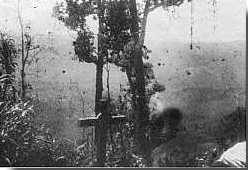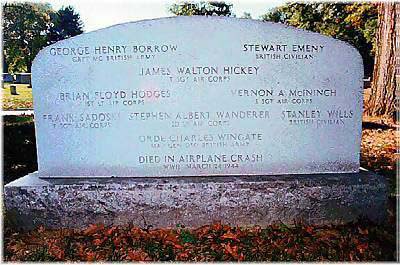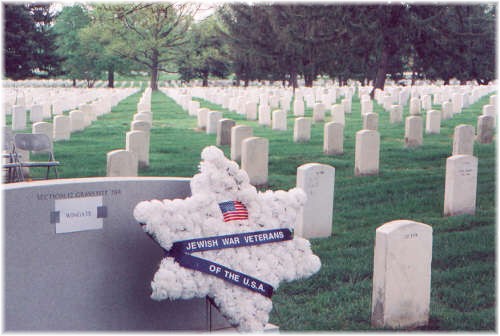Q u e s t i on a b l e R e s t
G r a v e
G r a v e
G r a v e
The Search
photo caption
B-25 bombers belonging to 1st Air Commando above their base in India, the same kind of aircraft Wingate perished in.
Photograph courtesy of US Air Force


The aftermath of his death has not been free from controversy either. Stories circulated that the night of the flight Wingate flew was stormy with turbulence, and this was picked up and played in the newspaper reports of the day. In fact personal at Imphal and in the air nearby experienced no bad weather, the flying conditions being clear with only dark skies and scattered clouds. After meeting with Wingate at Imphal, RAF Air Marshall Baldwin had flown out just after Wingate's departure, and encountered no difficulty. The B-25 aircraft Wingate flew on was under guard from sabotage the entire time it sat on the airfield. The night of the crash the crew of a nearby C-47 aloft saw a fiery explosion on the ground, and in good visibility was able to pinpoint the location.
photo caption
Gravesite with original cross and plaque.
Photo courtesy of the Imperial War Museum, London
The next day air search located a crash site. Fearing the worst after Wingate's flight was reported overdue, Chindit Special Force headquarters dispatched a small ground search party. Two days after the crash, the ground team and an aircraft arrived at the crash site near the ridge-top summit at 7,000 feet. They found a large impact crater still smoldering and mangled aircraft and body parts strewn about. A pith helmet, personal messages addressed to Wingate, along with his aide's revolver helped in the identification. Remains were buried deep in the impact crater originally by a group of Naga (an Indian ethnic group).


A signal was sent out to all Chindit units confirming Wingate's death. Three months later another expedition arrived and found some more remains and buried them at a shallower depth than the original ones were buried. Following a service, a cross & plaque containing the names of those who perished was planted at the crater's edge.
Controversy
Following the war's end, the remains were dug up and interned at the British military cemetery at Imphal. However, the only remains recovered were those by the cross planted by the second party and not those that were originally buried deep down in the impact crater the day after the crash. Thus most of the remains were not recovered.
Allied policy stated that when the circumstances of death prevented the ability to establish identity in the case of a group death of multiple nationalities, the remains were to be buried in the nation of the majority of the casualties. U.S. law authorized the removal of deceased American servicemen back to the U.S.A. So with the majority of deaths in the crash American, in November of 1950 the co-mingled remains were re-interned at the national U.S. cemetery in Arlington, Virginia. The U.S. government notified U.S. relatives of the deceased in advance while British relatives were not by theirs, to a minor uproar in Britain. It was the second, smaller group of remains that was transported first to the Imphal and then the Arlington cemeteries.
At the original crash site itself nothing distinguishable bears witness to what happened on the night March 24, 1944, which ended the life of Orde Charles Wingate.
photo caption
Orde Wingate's grave at
the Arlington National Cemetery, U.S.A. He
is buried in Area 12, Grave #288 along with 8 others, including his aide,
5 American crewmen & 2 journalists all of whom perished in the crash.
Photograph courtesy of
Ron Williams

1. Derek Tulloch, Wingate in War and Peace (London: History Book Club, 1972), 232.
2. Field Marshall Earl Wavell, Soldiers and Soldiering (London: Jonathan Cape, 1953), 105.
3. For full details on the aftermath of the crash, the investigation, and plausible theories see Dennis Hawley, The Death of Wingate (London: Merlin Books, 1994).

